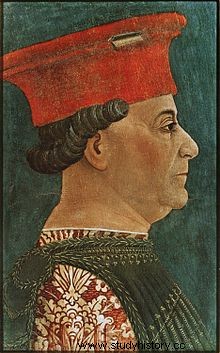
Beauty in the Middle Ages:Francesco Sforza with his hair dyed jet black
The habit of dyeing hair it is practically as old as man, just think
Beauty in the Middle Ages:Francesco Sforza without dye
to the skill in this sense of the Roman matrons, able to play with a wide range of colors to show off on their hair (https://www.pilloledistoria.it/1742/storia-antica/moda-dellantica-roma-tintura-dei-capelli), but we can say without fear of denial that it was only in the medieval period that this technique reached the pinnacle of fantasy.
Especially starting from the 1300s, everything became permissible to give the hair the desired color, also to cover the gray strands that appeared with advancing age; the remedies were essentially based on plant elements extracted from herbs and flowers , but also of minerals and even … animal excrement .
For the sake of completeness, it should be added that hair dyeing in the Middle Ages it was not an exclusively female habit, on the contrary, men competed closely in this area, just think of Francesco Sforza , famous for the ease with which he used to appear in public once with gray hair and other times jet black (in the photos, in both versions).
Even in the Middle Ages, however, as it always happened, it was not the natural graying of hair that worried men most, but baldness: the “pelatina”, as it was ironically defined in the 1400s, it was for centuries the greatest worry of men in terms of aesthetics.
Tips and advice regarding the prevention and treatment of hair loss were wasted and every concoction was good to avoid it; the doctors of the time did all they could to help in this, such as the famous Aldobrandino da Siena , who recommended avoiding the use of soap, washing only with warm water and greasing the scalp with rosy oil or myrrh.
In many medieval texts, a remedy often suggested to ward off "pelatina", hated also because it represented one of the typical symptoms of syphilis, at the very frequent time, it was the " Artemisia Abrotanum “. (Photo gives:wikipedia.org and storiadimilano.it)
